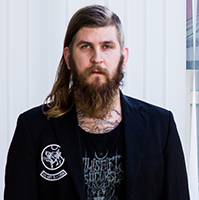
Featured Blog | This community-written post highlights the best of what the game industry has to offer. Read more like it on the Game Developer Blogs or learn how to Submit Your Own Blog Post
Defining Your USPs And Positioning Yourself: What Is This Game?
We take a look at how to use your USP to make a position statement and how that could help with your marketing strategy. It might also bring some interesting insights into your team composition, and then we end it all with some chocolate. And a tired meme


Johan Toresson (@jtoresson, [email protected])
Gameport (Blekinge Business Incubator)
If you haven't read the Indie Game Marketing-article I put up during the fall, feel free to check it out! You can find the first part here: Indie Game Marketing: A love story - Part 1 [Getting a solid base]
First it might be a good thing to delve a tad deeper into what USP and positioning is, at least in the context of this article. I’ve chosen to go with the definition used by Rosser Reeves when it comes to USPs (Unique Selling Propositions, or as I personally prefer it: Unique Selling Points), although I’d argue that it’s not the only good definition out there. It’s a decent one though, and it’s to the point. It’s also easy to translate into questions that could help you define your USP.
Each advertisement must make a proposition to the consumer—not just words, product puffery, or show-window advertising. Each advertisement must say to each reader: "Buy this product, for this specific benefit."
The proposition must be one the competition cannot or does not offer. It must be unique—either in the brand or in a claim the rest of that particular advertising area does not make.
The proposition must be strong enough to move the masses, i.e., attract new customers.
You can find this on the USP-wiki and click away from there for some more information on Reeves if you’re interested.
Keeping true to my wiki-definitions I’ll then move on to the positioning part. A position statement, as defined by Geoffrey Moore.
For (target customer) who (statement of the need or opportunity), the (product name) is a (product category) that (statement of key benefit – that is, compelling reason to buy). Unlike (primary competitive alternative), our product (statement of primary differentiation).
This could be translated into “For (young, jaded hipster who grew up liking games) who (now feels that games have strayed too far into the mainstream), (Unbearable Sounds and Glitchy Graphics) is a (shit game) that (no one else have played or will play except one lonely Brooklyn developer who in fact also developed this game). Unlike (Call of Dogs), this game (will make you feel unique).” Remove the snarkiness and you can easily see how this complements/works in mysterious ways with the USP definition. Note though that I’ll be quite liberal in how I use these definitions, as we’re not necessarily going to focus on an advert for your product – but rather getting the knowledge that you can use to base your marketing on. If you know what you are and what you are doing – it’d be much easier to draw up a marketing campaign.
Now then, why is this of interest to you? As a lean, mean indie machine you’re already labeled with all the USPs you need – and your position is that of the lone gunwoman/women/man/men trudging away towards that golden sunrise. But do you convey that to the people that’ll finance your next game? Do people know, care or understand your USP? Do you? If you do know, does the rest of the team? Are all definitions of your USP the same when you discuss it in your team? If not – why do they differ and can you gain anything from that? This is what we’ll try to find out, if you’d be so kind to stay a while and listen.
Defining your USP, using it and environmentally conscious chocolate
And I see all the young believers, your target audience. I see all the old deceivers, we all just sing their song – Brian Hugh Warner (Holy Wood)
So there’s a couple of ways to go about this, but my test subjects (workshop attendees) have enjoyed this one quite a bit. We’ll simply start out by asking some questions that I picked up while reading on startups, they kind of summarize the questions asked by a lot of the articles on USPs on the web. They’ve been translated a bit to work better in a game development context.
What are you? (Programmer? Designer? Designing programmer with managerial tasks?)
Why are you? (What role do you fill in the team that no one else does?)
What is it that your game does that fills a gaping hole in the games market today?
How are you doing that? (What part of your game actually fills that hole?)
What is five reasons that makes your game different from the competition?
Why is each and every one of these reasons better than what the competition does?
What people should care about it? (Define your target audience)
Why should people care about it?
If you’re a one-person team, this should give you a good place to start off. It’s kind of an oversight of your company, and it also takes away some abstract fluff and makes it much more concrete. By defining your role you might also see where you could use another skill, either by hiring or by learning it yourself.
If you’re more people on the team though, this should be done by each and every member for themselves. Afterwards I’d suggest that you gather around and discuss your answers. Do you have a programmer that is swamped with designing the HUD? A sound engineer that also doubles as a community manager? Does someone feel that X is the reason your gaming is filling hole Y, while someone else is feeling that Y doesn’t even exist and you’re instead working on the gap U with fitting piece B? This might spark quite a lot of discussions which, if used in a constructive way, might get everyone on the same page as to what the game is, where it’s going and why. It might also not be the page you’re thinking about right now. ´
After said discussions you’ve hopefully reached some conclusions, and have at least five reasons as to why your game is better than your competition and how it relates to the rest of the market (i. e how it fits in). If you’re then getting your creative marketing hat on you could revisit this USP document (because you did write it down now, didn’t you?) and work with the conclusions/answers you’ve reached. With these it should be easy(easier) to get from bullet points to a position statement, and from that statement to a creative marketing campaign based upon what makes you and your game stand out. (You can get the “you”-part by using your company as a the product in the aforementioned questions)
We could look at a company like The Mast Brothers, a chocolate company based out of Brooklyn. They sell chocolate. Good chocolate at that. But what sets them apart is that they make each and every bar from scratch, they also get their cocoa shipped via a sailboat. In the video they get 20 tons of cocoa beans by a boat that has sailed 15 days from the Dominican Republic. It was the first time a sailing ship unloaded commercial cargo in N.Y since 1939 (which obviously brought about some good press coverage, heeeeey creative marketing hipsters!). SO not only do they produce excellent chocolate from high quality beans by hand from scratch, they get it without unnecessary polluting- relying on wind power rather than oil. This puts forth some quite interesting USPs – it’s chocolate not only for those who know great chocolate, but for people who want locally produced environmentally conscious hand crafted chocolate. It not only tastes good, it is good. For you, for the environment and for the community. They also have beards. You could go on dissecting this and find more interesting stuff, but I don’t want to bore you now that you’re on your way to the Mast Brothers homepage to get some premium chocolate delivered.
I want to know more:
Reeves, Rosser – Reality in Advertising (1961)
Tim Hindle - Guide to Management Ideas and Gurus (2008)
Alyssa Gregory - 6 Steps to Creating a Unique Selling Proposition
BL Copywriting (Brenda) – What’s Your Unique Selling Proposition
There's tons of other USP-creating articles out there, but these two cover the basics without blurting about for >1300 words. (Sorry bout that) Other than that, feel free to e-mail me for more articles on the subject (or ask in the comments)!
Read more about:
Featured BlogsAbout the Author(s)
You May Also Like







.jpeg?width=700&auto=webp&quality=80&disable=upscale)








